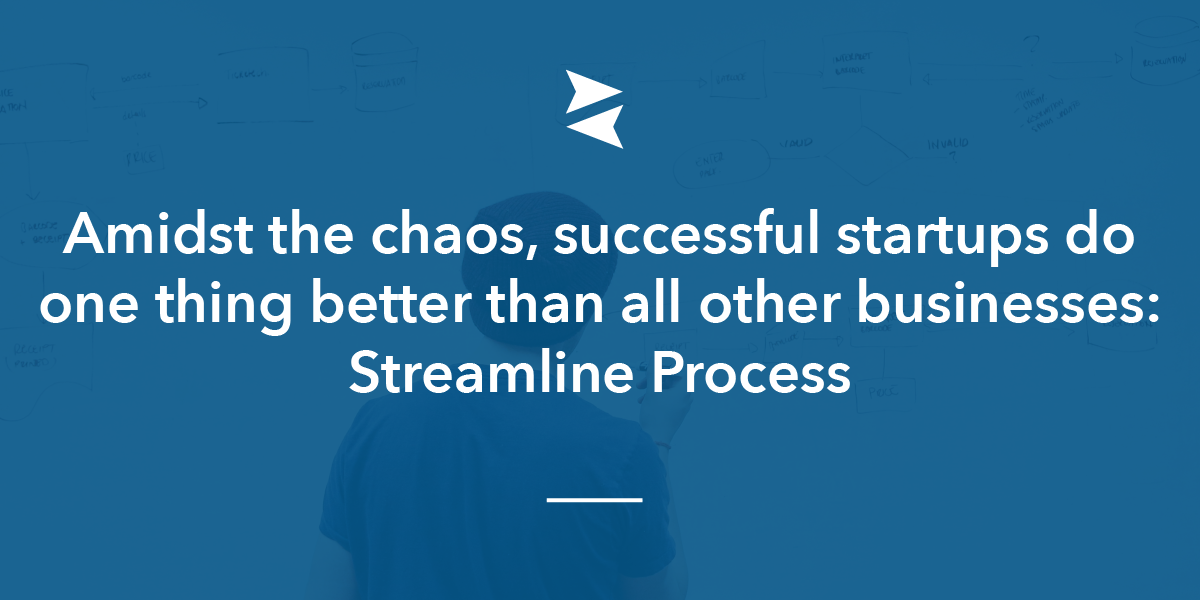The startup model has its flaws—instability, naiveté, long hours—making startups one of the last places one would think to look for an example of high-functioning business operations. But amidst the madness, startups that succeed are doing one thing better than more traditional small businesses and other startups: streamlining process.
Companies of all sizes rely on a number of processes to accomplish their goals and stay afloat. Whether you want to file your taxes on time, manage employees efficiently, or ensure you are compliant with laws and regulations, it’s important to establish processes that tick these boxes. Startups, especially fast-growing ones, are good at relying heavily on systems and ways of automating to accommodate company changes and to allow business owners and staff to focus on money-making activities rather than tedious rudimentary tasks.
It’s in this way that more traditional businesses can learn from the startup playbook and unload some of the administrative and operational burdens business owners have taken on in the past. Here are four simple tactics you can borrow from startups to enhance your small business’s organizational processes.

4 Startup Tendencies SMBs Can Steal to Instantly Improve Business Operations
1. Seed your efforts where modern technology allows
Remember when you had to dial-in to use the internet? Today, most organizations rarely use their fax machines, and everyone has a cell phone. While that example might seem dramatic, a less cheeky idea—that can save a ton of money on paper, printers, filing cabinets, etc.—is going completely paperless.
With this simple change you get the added benefit of having all or as many systems as possible in the cloud. Cloud access means you can work from anywhere at any time, which, for some businesses, can quickly go from a nice convenience to an absolute necessity. Storing data in the cloud can also save you time—not only is every document in one place, with good naming conventions it’s all searchable and accessible, too.
You will likely still need a printer and pens, but you’ll use them less when you get your organization acquainted with Dropbox, Google Drive, DocuSign, and other inexpensive or free cloud-based document management systems. If you’re already using Microsoft tools, take a look at what Office 365 has to offer.
2. Find areas to implement internal process automation
With the landscape of business tools on the market, automating as much of your organizational process as possible just makes sense. As eMarketer reveals, more and more business leaders are incorporating early adoption of automation technology than ever before.
You can do this in many ways: commissioning custom-made software, using an existing app or tool that streamlines processes (e.g. your accounts, how you collaborate with staff, or how you collect new client information), or creating your own automated responses to actions using tools like Zapier or IFTTT.

Wondering which business tasks you should automate or outsource?
There will always be new ways to automate processes as new challenges arise and new apps hit the scene. To determine what you should automate, ask, “Is managing this activity going to improve my business’s offering or core competency?” If your answer is no, it’s time to explore apps and tools that can streamline your workload.
- Collaboration – Not every project milestone needs a meeting or an email for that matter. Enlist the help of a task management platform to eliminate many unnecessary emails and ensure that everyone on the project sees critical information.
- Communication – As it stands, most people use phone and email to communicate. Somewhere between the immediacy of a phone call or meeting and the documentation powers of email, sits chat platforms like Slack, HipChat, and Google (or “G”) Chat. Most instant messaging solutions are free or very affordable and have proven to effectively improve team productivity as well as bolster a sense of community within organizations.
- Proofreading – Typos are just as embarrassing as they are inevitable (even us writers make them from time to time), but you can’t run each and every message or document through a proofreader. Freemium tools like Grammarly help prevent mistakes before you hit send or submit and even come with handy plugins for certain internet browsers.
- Onboarding & HR – The onboarding process can be tedious with training, education, and relationship-building. Automated onboarding helps your new employees feel welcome without interrupting the day-to-day work of your existing team. With that, human resources solutions like JustWorks or Gusto handle much of what goes into being an employer with ease.
- Accounting & Taxes – As Entrepreneur magazine advises, you can’t make up for lost opportunities when it comes to your finances, so it simply makes more sense to outsource: “Find a good bookkeeper for day-to-day accounting and an even better CPA for tax accounting.” (In case you’re wondering, indinero clients only need one vendor for both accounting and bookkeeping as well as taxes because we handle it all for them.)
- Productivity – Track and monitor anything from sales to hours worked and words typed if it impacts your business. If there’s something you measure manually, chances are, a tool exists to do it for you. If not, that could mean you’ve stumbled on a great new business opportunity, so find yourself a software developer right away.
- Scheduling – Traditionally, solutions that handle timing, scheduling, and shift blocking are separate roles and processes in an organization. Using a shift management software that combines everything in one place is a great way to simplify. Host information where multiple people can access it to save space, time, and money and avoid confusion.
3. Schedule time to monitor & review your efforts
Things change quickly at startups who are constantly reinventing their process. While some may see this as chaotic, there is something to be said for never getting too comfortable or set in your ways. Borrowing inspiration from that startup style agility at your established business can give you a better eye for evaluating good process from bad and avoiding unnecessary bureaucracy.
Time can fly by quickly when you’re running a business. It may seem like a bore, but regularly reviewing your organizational processes is the only way you can continually improve them to grow your business. This shouldn’t be too hard to do when most business apps and tools collate data relating to what you are using that system for, even if it’s just sign-in records.
Schedule reminders to review your organizational processes, both by looking at the data and by asking your team about what is and isn’t working. If the systems you use don’t offer analytics or if your staff can’t confidently estimate how long they spend on tasks, then consider using an app like Office Time or Hubstaff which will track activity on computers and mobile devices.
4. Outsource when your situation calls for it
There comes a time for every small business owner when you have to ask yourself how much your time is worth?
It helps to put a value on your time, which is easy if you charge clients an hourly, project, or daily rate. You can also use this free tool from Clearer Thinking to determine your hourly rate, how much you value your time, and when it makes sense to outsource all kinds of tasks, from doing your laundry to, yes, bookkeeping and accounting.
If the cost of handling tasks outside of your skillset is more than what it would cost you to outsource, then you should seriously think about finding a service provider to take on the other work.
Where can you find people online to outsource your work?
Don’t contract your work to just anyone. Any work you choose to outsource should be in expert hands. Freelancers can be a great place to look—especially as you look to outsource highly specialized tasks:
Tip: Another place to find the right experts is through your software providers. Many times, companies that automate a task or business function maintain a list of partners or individuals who hold certifications in their platform. If you don’t see a list on your provider’s website, reach out to an account representative to see if they have any recommendations.
Your Checklist of Habits to Steal from Startups:
In summary, here are the four startup-inspired operational strategies you can start implementing today:
- Go paperless to save time, money, and effort.
- Monitor and track yourself and employees to see where you can make improvements.
- Make time to review and revise your operational performance.
- Outsource menial tasks to experts for efficient use of everyone’s time.
What other productivity improvements have you made at your business recently?
Share your advice in the comments:

